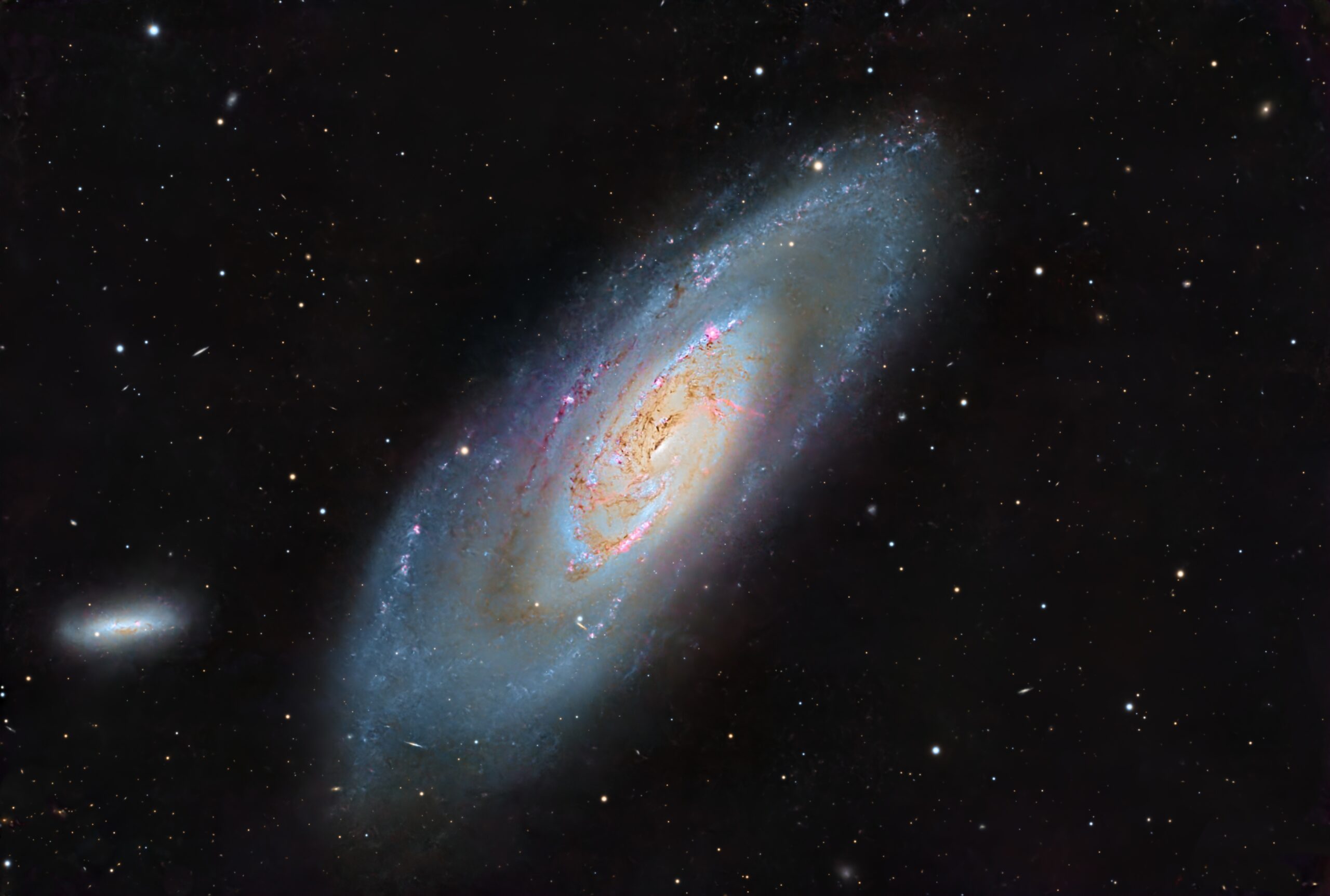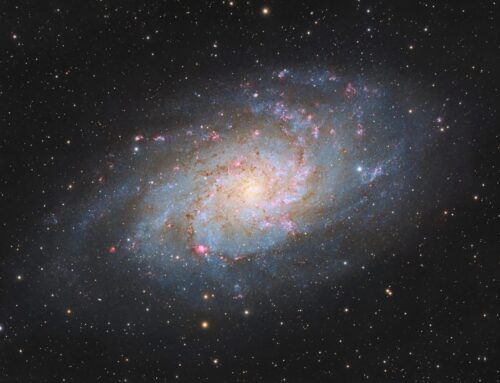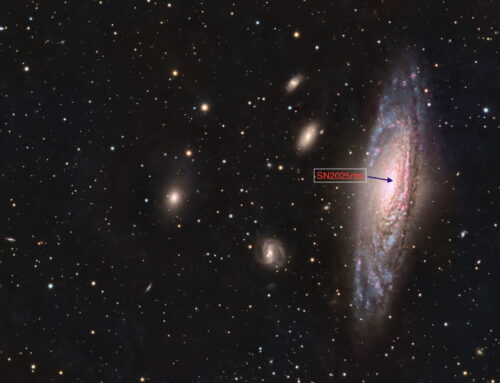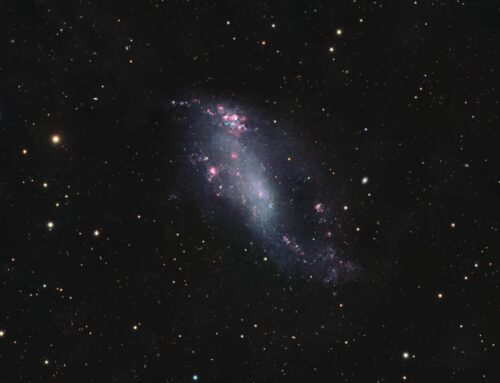Messier 106
Click image for full size version
April 19, 2025
M106, the 106th entry in Charles Messier’s catalogue, is a pretty spiral galaxy around 24 million light years away. It is situated in the constellation Canes Vanatici (the Hunting Dogs), not far from the Big Dipper. The galaxy shows lots of pink nebulae and bluish spiral arms. M106 is classified as a Seyfert galaxy, meaning it has an active nucleus. It’s thought that part of the galaxy is falling into a supermassive black hole near the centre — it is sort of cannibalizing itself. The other prominent galaxy, at lower left, is NGC 4248. It also shows pink nebulae. There are many more galaxies in this image. Look for fuzzy patches and needle-like structures that look different from the sharp, round stars.
I have imaged this galaxy previously, most recently in 2021 in a wider field.
Tekkies:
Acquisition, focusing, and control of Paramount MX mount with N.I.N.A., TheSkyX and PHD2. Primalucelab low-profile 2″ Essato focuser and ARCO rotator. Guiding with PHD2. Equipment control with PrimaLuce Labs Eagle 4 Pro computer. Flats taken using a Primalucelab Giotto 430 mm flat panel. All pre-processing and processing in PixInsight. Acquired from my SkyShed in Guelph. Data acquired under nearly moonless skies with average or better transparency and and average seeing between March 27 and April 17, 2025.
Celestron 14″ EDGE HD telescope at f/11 (3,912 mm focal length) and QHY600M camera binned 2×2 with Optolong filters.
85 x 5m Red = 7hr 05m
82 x 5m Green = 6hr 50m
83 x 5m Blue = 6hr 55m
135 x 5m Ha = 11hr 15m
Total: 32hr 05m
Preprocessing: The WeightedBatchPreProcessing script was used to perform calibration, cosmetic correction, weighting, registration, integration and Drizzle integration of all frames (1x drizzle, 0.9 Drop Shrink).
RGB and SynthL masters: A master RGB image was made from the Red, Green and Blue Drizzled masters using ChannelCombination in RGB mode. A synthetic luminance (SynthL) master was made from the R-G-B masters using ImageIntegration with weighting by SNR.
Gradient Removal: DynamicBackgroundExtraction was applied to the SynthL, RGB and Ha masters.
Colour Calibration: BlurXterminator was applied to the RGB master with Correct Only selected, followed by ColorCalibration.
Deconvolution: BlurXterminator was applied to the RGB, SynthL, and Ha masters with Automatic psf , star sharpening set to 0.5, and non-stellar set to 0.9.
Linear Noise Reduction: NoiseXterminator was applied to the RGB, SynthL, and Ha masters with settings Amount=0.9 and Detail=0.25.
Ha Continuum Subtraction: The PhotometricContinuumSubtraction script, by Carl Hagen, was used to remove continuum emissions from the Ha master using the red channel of the RGB master as the continuum reference image.
Stretching: HistogramTransformation was applied to make a pleasing image from the RGB, SynthL, and Ha masters. Approximate background level after stretch was 0.1 for SynthL and 0.08 for the Ha and RGB masters.
Nonlinear Processing
Luminance-RGB addition: LRGBCombination was applied to replace the lightness of the RGB image with the Luminance master.
Star Removal and processing: StarXterminator was used to remove the stars from the LRGB and Ha masters with Unscreen checked. The Ha stars were discarded. Colour was increased in the LRGB stars-only image by applying Curves saturation through a star mask.
Initial Saturation Boost: CurvesTransformation’s saturation tool was used to boost colour in the galaxies in the LRGB image using a range mask made with RangeSelection to protect the background.
H-alpha Blending: The contiuum-subtracted Ha was added to the LRGB image using Jurgen Terpe’s CombineHaWithRGB script.
Nonlinear Noise Reduction: NoiseXterminator was applied to the HaLRGB image with settings Amount=0.9 and Iterations=5. SCNR was applied (Green; average neutral, 60%).
Contrast Enhancement: Jergen Terpe’s CreateHDRImage script was applied to compress the core of the galaxy slightly. LocalHistogramEqualization was then applied twice. A Contrast Limit of 1.5 and 1 iteration was used for each application (scale 40, strength 0.25 and scale 150, strength 0.3). DarkStructureEnhance was applied with default settings except amount=0.2.
Sharpening: MultiscaleMedianTransform was used to sharpen Layers 1 – 5 with strengths of 0.03, 0.05, 0.05, 0.04, and 0.03, respectively.
Star Restoration: Stars were added back into the image using the PixelMath expression combine(starless, stars_only, op_screen())
Final Steps: Background, galaxy and star brightness, contrast and saturation were adjusted in several iterations using CurvesTransformation with masks as required. ICCProfileTransformation (sRGB IEC61966-2.1; Relative Colorimetric with black point compensation) was applied prior to saving as a jpg. The finder chart was made using the FindingChart process. The AnnotateImage script was used to make the annotated image.







I just discovered your work, Mr. Brecher, and it’s positively gorgeous!
Thanks!